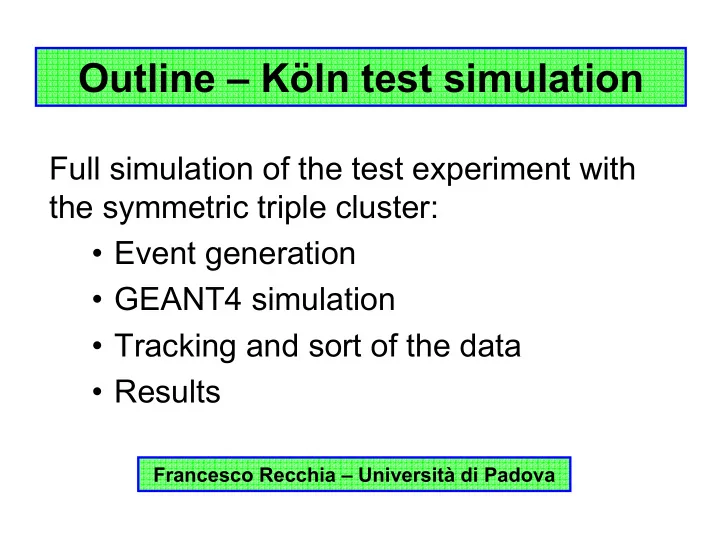

Outline – Köln test simulation Full simulation of the test experiment with the symmetric triple cluster: • Event generation • GEANT4 simulation • Tracking and sort of the data • Results Francesco Recchia – Università di Padova
Köln test experiment Reaction: d(47Ti,48Ti)p Reaction: d( 48Ti ,49Ti)p •direct (?) •fusion evaporation
Aim of the simulation Evaluate various Doppler Estimate the achieved correction methods: position resolution: •No PSA: Doppler correction • Comparing Doppler with segment broadening of peak in simulated and experimental •One interaction point per spectra segment •Full PSA
AGATA SIMULATION Monte Carlo Cascade- event Event simulation Monte Carlo for AGATA the AGATA array simulation and ancillaries detectors gamma mgt tracking gsort data sort
CASCADE-Event Target Nucleus ⇒ ⇒ Compound ⇒ Formation 10 -22 sec Fusion Beam Nucleus n p 10 -19 sec Particle n Cascade - Event Evaporation α ⇒ parametric CASCADE cross-sections 10 -15 sec calculation γ Emission γ Monte Carlo CASCADE-Event event simulation ⇒ 10 -9 sec Groundstate Simplified event generator
CASCADE-Event program CASCADE program Extract the residual INPUT output nucleus Particle decay ( α ,p,n) to reach the extracted MONTE CARLO residual nucleus Gamma decays to reach the discrete levels GAMMAWARE package Formatted input Discrete gamma-ray for the AGATA OUTPUT emission simulation
CASCADE-Event program Only fusion-evaporation channel WARNINGS: Statistical gammas from highly excited nuclei to known spectra need to be implemented. (see talk by C. Mihai) Köln test simulation case • Apparatus with low efficiency Simplified event generator • Analysis is focused on few peaks
SRIM calculation Target thickness Absorber Recoil and proton angular and beta distribution Beam angular distribution and beam spot
AGATA simulation From the CASCADE- INPUT Event program GEANT4 MONTE CARLO Follows particles and gammas inside the detector Symmetric triple cluster + Formatted for input ancillary silicon detector OUTPUT to mgt program
Data analysis mgt program From the AGATA Smearing gammas interaction INPUT simulation energies and position Gamma tracking gsort program OUTPUT Identification of particles In gsort format of in ancillary detectors particles and gammas detected and tracked Build coincidence matrices of gammas and particles Gammas/particles OUTPUT matrices and spectra
Various data analysis types Doppler correction average kinematic correction detector segment psa + tracking
Various data analysis types Doppler correction 1381 keV average kinematic correction Simplified PSA + max energy Simplified PSA + tracking Full PSA + max energy Full PSA + tracking
Various data analysis types FWHM (keV) @1381keV Detector ~35 Segment 15.5 Simplified PSA 4.13 max energy Simplified PSA 3.92 tracking Full PSA 3.94 max energy Full PSA 3.82 tracking Doppler correction after kinematic recalibration
Estimate the experimental position resolution position resolution (cm) Full PSA + tracking + kinematic correction
CONCLUSION • Simplified PSA and full PSA produce similar FWHM results GOOD STARTING POINT • Through the comparison between the simulation of the Köln test experiment and the experimental data it will be possible to estimate the experimental position resolution
Recommend
More recommend